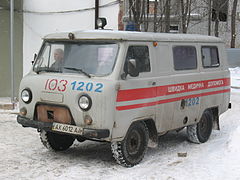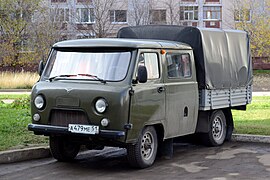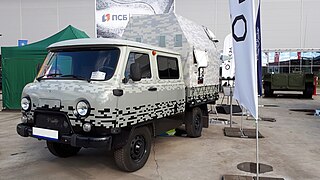
A van is a type of road vehicle used for transporting goods or people. Depending on the type of van, it can be bigger or smaller than a pickup truck and SUV, and bigger than a common car. There is some variation in the scope of the word across the different English-speaking countries. The smallest vans, microvans, are used for transporting either goods or people in tiny quantities. Mini MPVs, compact MPVs, and MPVs are all small vans usually used for transporting people in small quantities. Larger vans with passenger seats are used for institutional purposes, such as transporting students. Larger vans with only front seats are often used for business purposes, to carry goods and equipment. Specially equipped vans are used by television stations as mobile studios. Postal services and courier companies use large step vans to deliver packages.
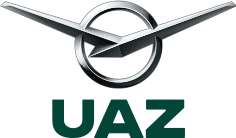
UAZ or Ulyanovsky Avtomobilny Zavod is an automobile manufacturer based in Ulyanovsk, Russia, which manufactures off-road vehicles, buses and trucks. It has been part of the Sollers automotive group since 2000.

The Volkswagen Type 2 is a forward control light commercial vehicle introduced in 1950 by the German automaker Volkswagen as its second car model. Known officially as the Transporter, Kombi or Microbus, or, informally, as the Volkswagen Station Wagon (US), Bus, Camper (UK) or Bulli (Germany), it was given the factory designation Type 2 as it followed – and was initially derived from – Volkswagen's first model, the Type 1 (Beetle).

The Mazda Bongo, also known as Mazda E-Series and the Ford Econovan, is a cabover van and pickup truck manufactured by the Japanese automobile manufacturer Mazda since 1966. The Bongo name was also used for the Bongo Friendee, which is not a cabover design.
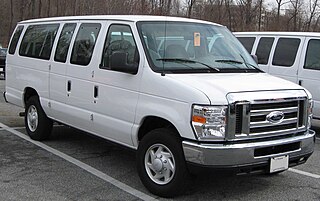
The Ford E-Series is a range of full-size vans manufactured and marketed by the Ford Motor Company. Introduced for 1961 as the replacement of the Ford F-Series panel van, four generations of the model line have been produced. Marketed for both cargo and passenger transport configurations, the E-Series has been designed with multiple design variations for both retail and commercial sale, including vans, and commercial-grade cutaway van chassis and stripped chassis.

The Chevrolet Express is a series of full-size vans produced by General Motors since 1996. The successor to the Chevrolet G-series van, the Express is produced in passenger and cargo variants. Alongside the standard van body, the line is offered as a cutaway van chassis; the latter vehicle is a chassis cab variant developed for commercial-grade applications, including ambulances, buses, motorhomes, and small trucks.

Ford Courier is a model nameplate used by Ford since the early 1950s. The Courier moniker has been used on a variety of vehicles all around the world since it was first used in North America for a sedan delivery. The Courier nameplate was also used by Ford for a series of compact pickup trucks and would also see use by Ford of Europe denoting a Fiesta-based panel van. Ford Brazil used the nameplate for a Fiesta-based coupe utility pickup marketed across Latin America.

The GAZelle is a series of light commercial vehicle—pickup trucks, vans and minibuses—made by Russian car manufacturer GAZ. At the time of the dissolution of the Soviet Union and transition to a market economy, the Russian automobile industry had not produced a much-demanded LCV similar to the Ford Transit or VW T4 class. The GAZelle shares many parts with the company's passenger cars ; in fact, models produced until 1998 had the same grille. Riga Autobus Factory, which formerly manufactured minibuses for the whole USSR, remained in Latvia, and now required its vehicles be sold to the now-foreign Russian market for hard currency. Responding to this market opportunity, GAZ swiftly developed its own LCV called GAZelle, which, taken together with its lighter version, Sobol, now account for the majority of the Russian van and light truck market and have strong positions in the markets of other CIS countries, ranking as GAZ's most popular and successful products.

The Dodge Ram Van is a range of full-size vans that were produced by Chrysler Corporation from the 1971 to 2003 model years. Replacing the Dodge A100, the Ram Van transitioned to a front-engine drivetrain configuration. Mostly offered as a cargo van and a passenger van, the model line was also initially offered as a cutaway van chassis.

Dodge has used the B series name on two different vehicles, a pickup truck and a van.

The Datsun Truck is a compact pickup truck made by Nissan in Japan from 1955 through 1997. It was originally sold under the Datsun brand, but this was switched to Nissan in 1983. It was replaced in 1997 by the Frontier and Navara. In Japan, it was sold only in Nissan Bluebird Store locations.

The Jeep Forward Control is a truck that was produced by Willys Motors, later named Kaiser Jeep, from 1956 to 1965. It was also assembled in other international markets. The layout featured a cab over design.
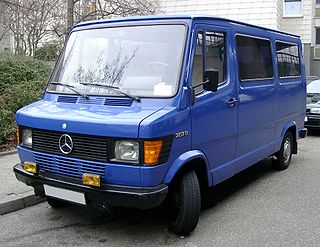
In 1977 Mercedes-Benz introduced a new van/truck, called T1 internally. Other designations were series TN / T1N and Bremer Transporter, since the vehicle was built in the Transporter-Plant in Bremen, Germany, first. In the years 1983/1984 production went - piece by piece - to the Transporter-Plant-Düsseldorf. The internal chassis-designations are: 601, 602 and 611.

The International Harvester Travelall is a model line of vehicles that were manufactured by International Harvester from 1953 to 1975. One of the first competitors of the Chevrolet Suburban, the Travelall was a truck-based station wagon, serving as a forerunner of modern people carriers and full-size sport utility vehicles.
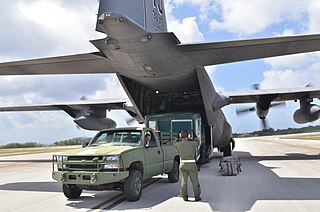
The Commercial Utility Cargo Vehicle (CUCV) is a vehicle program instituted to provide the United States military with light utility vehicles based on civilian trucks.

The UAZ Patriot (UAZ-3163) is a mid-size body-on-frame SUV produced by the UAZ division of SeverstalAvto in Ulyanovsk, Russia. It was introduced in 2005 and replaced the older UAZ Simbir (UAZ-3162). Extensive use of newer parts, large carrying capacity, good off-road capabilities and an affordable price predicted good sales in Russia. 12,011 units were sold in the year 2007.

The Chevrolet Van or Chevy Van is a range of vans that was manufactured by General Motors from the 1964 to 1996 model years. Introduced as the successor for the rear-engine Corvair Corvan/Greenbrier, the model line also replaced the panel van configuration of the Chevrolet Suburban. The vehicle was sold both in passenger van and cargo van configurations as well as a cutaway van chassis that served as the basis for a variety of custom applications.

The Toyopet Master, introduced in January 1955, is a passenger car that was an evolution of the earlier Toyota SF/RH sedan with a modernized body. As with its predecessor, the Master has a ladder frame truck chassis with leaf sprung solid axles both at the front and the rear. The more conservative Master was sold in parallel with the first Toyota Crown as a frugally equipped and robust version meant for taxi usage. The Master and Crown shared the same R-series engine, which produces 48 PS (35 kW) in the Master. It was sold at a chain of Toyota Japan dealerships called Toyota Store, next to the more upscale Crown, which was intended as a private purchase alternative to the Master.

The Krasnodar mechanical plant of non-standard equipment, commonly known as AvtoKuban, was a Soviet/Russian company that manufactured buses based on truck chassis.

The fourth generation of the C/K series is a range of trucks that was manufactured by General Motors. Marketed by the Chevrolet and GMC brands from the 1988 to the 2002 model years, this is the final generation of the C/K model line. In a branding change, GMC adopted the GMC Sierra nameplate for all its full-size pickup trucks, leaving the C/K nomenclature exclusive to Chevrolet.
This article has been brought over from the Russian Wikipedia article.










